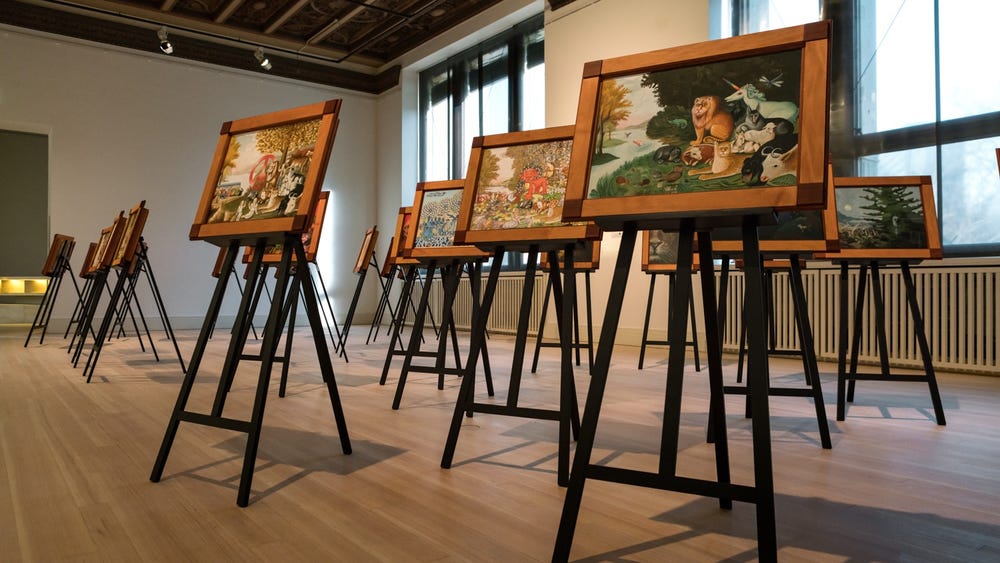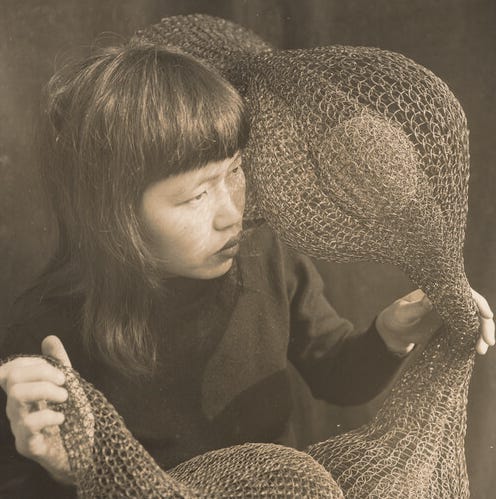How Artist Chelsea Ryoko Wong Created Her Own Vision of Peace
By Magnolia Molcan, senior web managing editor, in conversation with artist Chelsea Ryoko Wong
December 28, 2023
Lee Mingwei (American, b. Taiwan, 1964), Our Peaceable Kingdom, 2020–present. 39 framed paintings, easels, 17 5/16 x 23 10/16 in. each (44 x 60 cm each). Photo courtesy of Gropius Bau, photo by Laura Fiorio
A wolf and a lamb curl up together while Quakers and Lenape amiably meet in Edward Hicks’s The Peaceable Kingdom (1833, Worcester Museum of Art). Hicks created 62 versions of this work, including one in our collection at the de Young. In Lee Mingwei’s Our Peaceable Kingdom (2020 to present), he invites artists to propose their own models of peace by copying or reworking Hicks’s painting. He then asks each to choose two other artists to do the same. Here, Chelsea Ryoko Wong tells us about her experience participating in the project and how she created her own vision of peace.
Magnolia Molcan: How did you approach the Our Peaceable Kingdom project?
Chelsea Ryoko Wong: Because I joined this project in its later stage, I was able to look at existing paintings created for Our Peaceable Kingdom. I wanted to get a sense of how other artists approached the project — what they chose to include or omit, and how they re-imagined the canvas to be unique to their vision.
It was important for me to examine the work both historically and visually, and also research the context of the artist’s life and practice. I found Hicks’s vision of peace between Quakers and the Indigenous tribes noble and yet idealized. So, when tasked with recreating this work, it was important to me to highlight the context in which we now view this part of history.
Edward Hicks (1780-1849), The Peaceable Kingdom, ca. 1846, Oil on canvas, 25 1/4 x 28 3/4 in. (64.135 x 73.025 cm). Fine Arts Museums of San Francisco, Gift of Mr. and Mrs. John D. Rockefeller 3rd, 1993.35.14
The process of copying a painting was fascinating and challenging, as artists do not provide roadmaps to reproduce their works. It involved a lot of problem-solving, but luckily Lee Mingwei gave full artistic license for this project.
MM: Can you tell us a bit about your finished work?
CW: In the de Young’s version, we see animals and the Lenape coexisting, with a ship arriving offshore carrying European settlers bearing gifts.
For my finished work, I took liberties in creating a version that felt aligned with my own vision of peace. There are elements in the original painting that I honored, including the general composition, animals, landscape, and nature. There are other elements I changed: I removed the settlers and their ship, and painted the Lenape with human skin tones. I wanted my version of this painting to honor Hicks’s work but also reimagine the landscape devoid of colonization.
Chelsea Ryoko Wong, The Peaceable Kingdom, 2023. Courtesy of Lee Studio and the artist Chelsea Ryoko Wong
MM: How did you choose the two additional artists to participate?
CW: The two other artists, Emily Fromm and Emilio Villalba, are local painters with varying styles and points of view. I admire both of their practices, and because they work in distinct styles, I was interested to see how they would approach the project.
Emily Fromm, The Peaceable Kingdom, 2023. Courtesy of Lee Studio and the artist Emily Fromm
MM: Did they approach the project differently? What were you surprised or excited by in their finished pieces?
CW: Yes. Stylistically their work is very different. Emily Fromm’s work is graphic in nature, and she chose to use a limited palette, which is a defining characteristic of her practice. Emilio Villalba, on the other hand, is primarily an oil painter who builds his canvas with layers of thick, rich paint.
The contrast between the two resulted in two beautifully distinct works, both stunning in their approach to the project. I was excited but not surprised how successful both works are — in the dimensionality, palette, context, and depth.
Emilio Villalba, The Peaceable Kingdom, 2023. Courtesy of Lee Studio and the artist Emilio Villalba
MM: How did your experience participating in Lee Mingwei’s artwork impact you?
CW: This opportunity gave me the space to consider the concept of peace in contemporary times through the examination and creation of one piece of art. It was interesting to learn about the Quakers and their beliefs around art at the time Edward Hicks was alive. Art was deemed too “ornamental” in contrast to living a plain and simple life. As a Quaker minister, Hicks adapted his practice to contain biblical scenes so that he could continue painting, which I found to be an inspiring testament to his bravery and dedication.
My participation in this artwork leads me to reflect on our roles as artists in how we perceive the world, and how our work is impacted by the passage of time and history.










